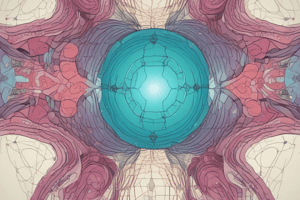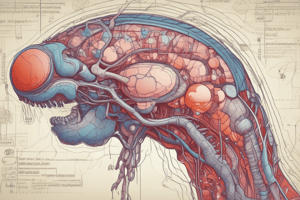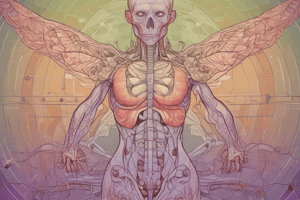Podcast
Questions and Answers
What is the primary function of the nervous and endocrine systems?
What is the primary function of the nervous and endocrine systems?
- To coordinate functions of all body systems (correct)
- To conduct nerve impulses along axons
- To synthesize and break down receptors constantly
- To produce hormones that influence target cells
What is the primary function of endocrine glands?
What is the primary function of endocrine glands?
- To produce hormones that influence metabolic activity (correct)
- To produce digestive enzymes
- To regulate body temperature
- To filter waste and excess fluids from the blood
What is the term for the scientific study of hormones and the endocrine organs?
What is the term for the scientific study of hormones and the endocrine organs?
- Neurology
- Anatomy
- Endocrinology (correct)
- Physiology
What is the role of neurotransmitters in the nervous system?
What is the role of neurotransmitters in the nervous system?
What happens to the number of receptors in the body when there is a deficiency of a hormone?
What happens to the number of receptors in the body when there is a deficiency of a hormone?
What is the name of the part of the thyroid gland where the parathyroid gland is located?
What is the name of the part of the thyroid gland where the parathyroid gland is located?
What is the term for the mediator substance of the nervous system?
What is the term for the mediator substance of the nervous system?
Where are hormone receptors typically located?
Where are hormone receptors typically located?
What is the characteristic of the cell membrane that allows lipid-soluble hormones to pass through?
What is the characteristic of the cell membrane that allows lipid-soluble hormones to pass through?
What is the term for hormones that are produced by endocrine glands and transported through the bloodstream to reach their target cells?
What is the term for hormones that are produced by endocrine glands and transported through the bloodstream to reach their target cells?
How many receptors does a target cell typically have for a particular hormone?
How many receptors does a target cell typically have for a particular hormone?
What is the primary difference between the nervous and endocrine systems?
What is the primary difference between the nervous and endocrine systems?
What is the effect of a hormone deficiency on the number of receptors in the body?
What is the effect of a hormone deficiency on the number of receptors in the body?
What is the term for the release of mediator molecules at synapses?
What is the term for the release of mediator molecules at synapses?
Which of the following endocrine glands is responsible for regulating metabolism?
Which of the following endocrine glands is responsible for regulating metabolism?
What is the term for the process by which the body increases the number of receptors in response to a hormone deficiency?
What is the term for the process by which the body increases the number of receptors in response to a hormone deficiency?
What happens to the hormone concentration in the blood when an endocrine gland is induced?
What happens to the hormone concentration in the blood when an endocrine gland is induced?
What is the primary function of the pituitary gland in regulating hormone secretion?
What is the primary function of the pituitary gland in regulating hormone secretion?
What is the function of the infundibulum in relation to the pituitary gland?
What is the function of the infundibulum in relation to the pituitary gland?
What is the result of a decrease in stimulation of an endocrine gland?
What is the result of a decrease in stimulation of an endocrine gland?
What is the location of the pituitary gland?
What is the location of the pituitary gland?
What is the shape of the pituitary gland?
What is the shape of the pituitary gland?
What is the size of the pituitary gland?
What is the size of the pituitary gland?
What are the two functionally separate portions of the pituitary gland?
What are the two functionally separate portions of the pituitary gland?
Study Notes
Endocrine Glands
- Endocrine glands are also called ductless glands because they produce hormones and lack ducts.
- They influence metabolic activity by means of hormones.
Organs Involved in the Endocrine System
- Pituitary gland
- Thyroid gland
- Parathyroid gland (located at the posterior portion of the thyroid gland)
Up-regulation of Hormone Receptors
- When there is a deficiency of a hormone, the body increases the number of receptors to compensate.
Circulating and Local Hormones
- Circulating hormones are produced by the hypothalamus and pituitary gland.
Chemical Classes of Hormones
- Lipid-soluble hormones can pass through the lipid bilayer of the plasma membrane.
Pituitary Gland
- Shape: pea-shaped
- Size: 1-1.5 cm (0.5 in.) in diameter
- Location: hypophysial fossa of the sella turcica of the sphenoid bone
- Has two functionally separate portions: the anterior pituitary and posterior pituitary
- Attaches to the hypothalamus by the infundibular stalk (infundibulum)
Anterior Pituitary
- Also called adenohypophysis (adeno- = gland; -hypo- = under; -physis = growth)
Other Endocrine Glands
- Adrenal gland: found on top of the kidneys
- Pineal gland
Introduction to the Endocrine System
- The nervous and endocrine systems act together to coordinate functions of all body systems.
- Endocrinology is the scientific study of hormones and the endocrine organs.
Hormonal Activity
- The nervous system acts through nerve impulses, conducted along axons of neurons.
- The endocrine system controls body activities by releasing mediators called hormones.
The Role of Hormone Receptors
- Hormones influence their target cells by chemically binding to specific protein receptors.
- Receptors are constantly being synthesized and broken down.
- The target cell has 2000 to 100,000 receptors for a particular hormone.
Studying That Suits You
Use AI to generate personalized quizzes and flashcards to suit your learning preferences.
Description
This quiz covers the basics of endocrine glands, hormone regulation, and their effects on metabolic activity.




